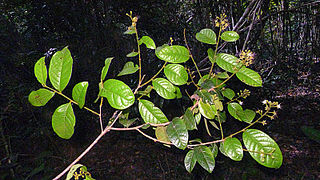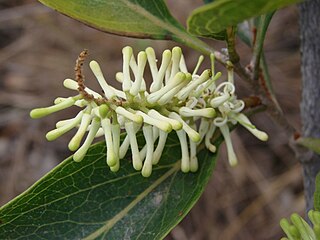
Hevea is a genus of flowering plants in the spurge family, Euphorbiaceae, with about ten members. It is also one of many names used commercially for the wood of the most economically important rubber tree, H. brasiliensis. The genus is native to tropical South America but is widely cultivated in other tropical countries and naturalized in several of them. It was first described in 1775.

Couratari is a genus of trees in the family Lecythidaceae, first described as a genus in 1775. They native to tropical South America and Central America.
Bactris campestris is a small spiny palm which grows in multi-stemmed clumps in savannas and low forests in northern South America from Colombia to the Guianas, Trinidad and Tobago, and northern Brazil.

Richeria grandis is a tree species in the family Phyllanthaceae which ranges from the Lesser Antilles to South America. The species is reputed to have aphrodisiac properties.

Hirtella is a genus of 110 species of woody trees in family Chrysobalanaceae. It was first described as a genus by Linnaeus in 1753. Hirtella naturally occurs in tropical forests throughout Latin America, the West Indies, southeast Africa, and Madagascar. The flowers are mainly pollinated by butterflies.
Licania splendens is a tree in the family Chrysobalanaceae. The specific epithet splendens is from the Latin meaning "shining", referring to surfaces of the dried leaves.
Parinari argenteo-sericea is a tree of Borneo in the family Chrysobalanaceae. The specific epithet argenteo-sericea is from the Latin meaning "silvery silky", referring to the pubescence of the inflorescence and flowers.

Parinari is a genus of plant in the family Chrysobalanaceae.

Roupala is a Neotropical genus of woody shrubs and trees in the plant family Proteaceae. Its 34 species are generally found in forests from sea level to 4000 m altitude from Mexico to Argentina.
Bagassa guianensis is a tree in the plant family Moraceae which is native to the Guianas and Brazil. It is valued as a timber tree and as a food tree for wildlife. The juvenile leaves are distinctly different in appearance from the mature leaves, and were once thought to belong to different species.
Bois bande or bois bandé is the common name of several West Indian tree species reputed to have aphrodisiac properties including:

Roupala montana is a species of shrub or tree in the family Proteaceae which is native to much of the Neotropics. It is a morphologically variable species with four recognised varieties. The species is used medicinally in Venezuela, and as an aphrodisiac in Trinidad and Tobago and Venezuela.

Parinari capensis, the sand apple, is a species of flowering plant in the family Chrysobalanaceae, found in Botswana, DRC, Mozambique, Namibia, South Africa, Tanzania and Zimbabwe. It is 20 centimetres (7.9 in) tall. The leaves are elliptic with a white underside. It has small white flowers and a hairy sand-coloured calyx.
Parinari canarioides is a tree in the family Chrysobalanaceae. The specific epithet canarioides is for the species' resemblance to the genus Canarium.
Parinari elmeri is a tree in the family Chrysobalanaceae. It is named for the American botanist Adolph Elmer.
Parinari metallica is a tree in the family Chrysobalanaceae. The specific epithet metallica is from the Latin meaning "metallic", referring to the metallic sheen on the leaves when dried.
Parinari oblongifolia is a tree in the family Chrysobalanaceae. The specific epithet oblongifolia is from the Latin meaning "oblong-leafed".
Parinari rigida is a tree in the family Chrysobalanaceae. The specific epithet rigida is from the Latin meaning "stiff", referring to the leaves.
Exellodendron is a genus of plant in the family Chrysobalanaceae described as a genus in 1972.
Scott Alan Mori was a botanist and plant collector. He specialized in the systematics and ecology of neotropical Lecythidaceae and Amazonian and Guianian floristics.







